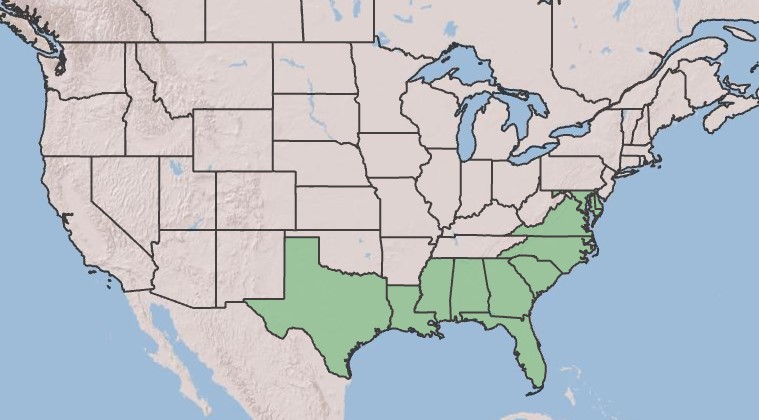Difference between revisions of "Persea palustris"
HaleighJoM (talk | contribs) (Created page with "{{subst:Template:PlantName}}") |
(→Habitat) |
||
| (3 intermediate revisions by 3 users not shown) | |||
| Line 2: | Line 2: | ||
<!-- Get the taxonomy information from the NRCS Plants database --> | <!-- Get the taxonomy information from the NRCS Plants database --> | ||
{{taxobox | {{taxobox | ||
| − | | name = | + | | name = Persea palustris |
| image = | | image = | ||
| image_caption = Photo by | | image_caption = Photo by | ||
| regnum = Plantae | | regnum = Plantae | ||
| divisio = Magnoliophyta - Flowering plants | | divisio = Magnoliophyta - Flowering plants | ||
| − | | classis = | + | | classis = Magnoliopsida - Dicotyledons |
| − | | ordo = | + | | ordo = Laurales |
| − | | familia = | + | | familia = Lauraceae |
| − | | genus = '' | + | | genus = ''Persea'' |
| − | | species = ''''' | + | | species = '''''P. palustris''''' |
| − | | binomial = '' | + | | binomial = ''Persea palustris'' |
| − | | binomial_authority = | + | | binomial_authority = (Rafinesque) Sargent |
| − | | range_map = | + | | range_map = PERS_PALU_dist.JPG |
| − | | range_map_caption = Natural range of '' | + | | range_map_caption = Natural range of ''Persea palustris'' from USDA NRCS [https://plants.sc.egov.usda.gov/home/plantProfile?symbol=PEPA37]. |
}} | }} | ||
| − | Common name: | + | Common name: swamp bay |
==Taxonomic Notes== | ==Taxonomic Notes== | ||
| − | Synonyms: | + | Synonyms: ''Persea borbonia'' var. ''pubescens'' (Pursh) Little; ''Tamala pubescens'' (Pursh) Small<ref name=weakley>Weakley, A.S. 2020. Flora of the Southeastern United States. Edition of 20 October 2020. University of North Carolina at Chapel Hill, Chapel Hill, North Carolina.</ref> |
| + | |||
| + | Varieties: none<ref name=weakley/> | ||
| + | |||
==Description== | ==Description== | ||
<!-- Basic life history facts such as annual/perennial, monoecious/dioecious, root morphology, seed type, etc. --> | <!-- Basic life history facts such as annual/perennial, monoecious/dioecious, root morphology, seed type, etc. --> | ||
| Line 25: | Line 28: | ||
==Distribution== | ==Distribution== | ||
==Ecology== | ==Ecology== | ||
| − | + | ===Habitat=== | |
| + | ''P. palustris'' can be found in wet pinelands, palmetto-pine-cedar hammocks, titi-sweetbay swamps, slash pine flatwoods, pond cypress swamps, sand pine dunes, marshes, streambanks, floodplains, scrubs, wetlands, and pond margins. It grows in wet, sandy soil.<ref name = fsu> Florida State University Robert K. Godfrey Herbarium database. URL: http://herbarium.bio.fsu.edu. Last accessed: June 2023. Collectors: Loran C. Anderson, Tom Barnes, Michael B. Brooks, Angus Gholson, Robert K. Godfrey, Bruce Hansen, JoAnn Hansen, S. R. Harrison, Roy N. Jervis, Walter S. Judd, Robert L. Lazor, Robert J. Lemaire, S. W. Leonard, Sidney McDaniel, Richard S. Mitchell, Elmer C. Prichard, Paul Redfearn, and Cecil R. Slaughter. States and counties: Florida: Alachua, Collier, Dade, Dixie, Franklin, Hamilton, Hernando, Jackson, Lake, Liberty, Marion, Orange, Osceola, Polk, Putnam, Taylor, Volusia, and Wakulla.</ref> | ||
| + | |||
| + | Associated species of ''P. palustris'' include ''[[Ilex myrtifolia]]'', ''[[Ilex coriacea]]'', ''[[Cliftonia monophylla]]'', ''Myrica cerifera'', ''[[Lyonia lucida]]'', ''[[Aronia arbutifolia]]'', ''[[Cyrilla racemiflora]]'', and ''Smilax laurifolia''.<ref name=fsu/> | ||
<!--===Phenology===--> <!--Timing off flowering, fruiting, seed dispersal, and environmental triggers. Cite PanFlora website if appropriate: http://www.gilnelson.com/PanFlora/ --> | <!--===Phenology===--> <!--Timing off flowering, fruiting, seed dispersal, and environmental triggers. Cite PanFlora website if appropriate: http://www.gilnelson.com/PanFlora/ --> | ||
<!--===Seed dispersal===--> | <!--===Seed dispersal===--> | ||
Latest revision as of 11:55, 20 June 2023
| Persea palustris | |
|---|---|
| Scientific classification | |
| Kingdom: | Plantae |
| Division: | Magnoliophyta - Flowering plants |
| Class: | Magnoliopsida - Dicotyledons |
| Order: | Laurales |
| Family: | Lauraceae |
| Genus: | Persea |
| Species: | P. palustris |
| Binomial name | |
| Persea palustris (Rafinesque) Sargent | |

| |
| Natural range of Persea palustris from USDA NRCS [1]. | |
Common name: swamp bay
Contents
Taxonomic Notes
Synonyms: Persea borbonia var. pubescens (Pursh) Little; Tamala pubescens (Pursh) Small[1]
Varieties: none[1]
Description
Distribution
Ecology
Habitat
P. palustris can be found in wet pinelands, palmetto-pine-cedar hammocks, titi-sweetbay swamps, slash pine flatwoods, pond cypress swamps, sand pine dunes, marshes, streambanks, floodplains, scrubs, wetlands, and pond margins. It grows in wet, sandy soil.[2]
Associated species of P. palustris include Ilex myrtifolia, Ilex coriacea, Cliftonia monophylla, Myrica cerifera, Lyonia lucida, Aronia arbutifolia, Cyrilla racemiflora, and Smilax laurifolia.[2]
Conservation, cultivation, and restoration
Cultural use
Photo Gallery
References and notes
- ↑ 1.0 1.1 Weakley, A.S. 2020. Flora of the Southeastern United States. Edition of 20 October 2020. University of North Carolina at Chapel Hill, Chapel Hill, North Carolina.
- ↑ 2.0 2.1 Florida State University Robert K. Godfrey Herbarium database. URL: http://herbarium.bio.fsu.edu. Last accessed: June 2023. Collectors: Loran C. Anderson, Tom Barnes, Michael B. Brooks, Angus Gholson, Robert K. Godfrey, Bruce Hansen, JoAnn Hansen, S. R. Harrison, Roy N. Jervis, Walter S. Judd, Robert L. Lazor, Robert J. Lemaire, S. W. Leonard, Sidney McDaniel, Richard S. Mitchell, Elmer C. Prichard, Paul Redfearn, and Cecil R. Slaughter. States and counties: Florida: Alachua, Collier, Dade, Dixie, Franklin, Hamilton, Hernando, Jackson, Lake, Liberty, Marion, Orange, Osceola, Polk, Putnam, Taylor, Volusia, and Wakulla.